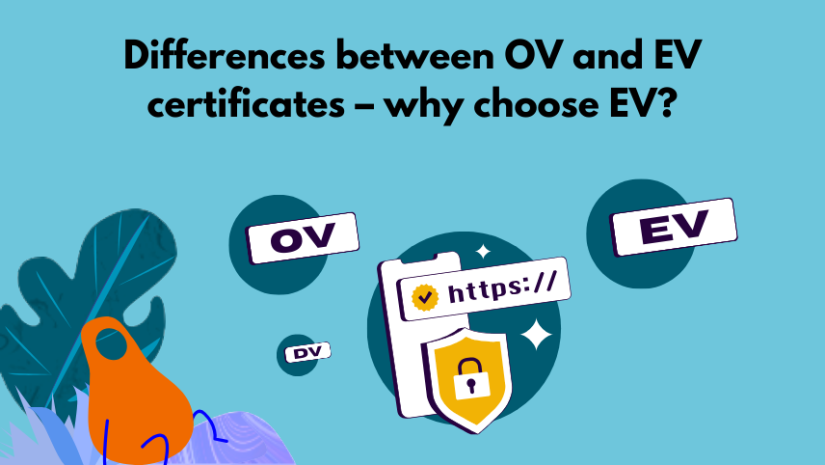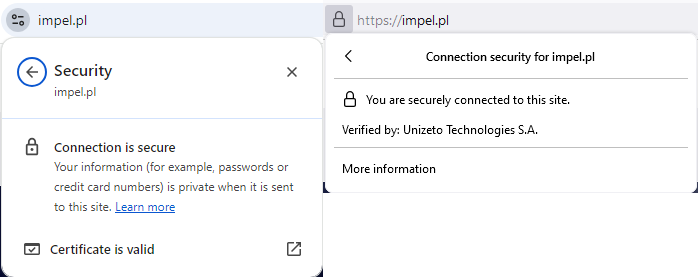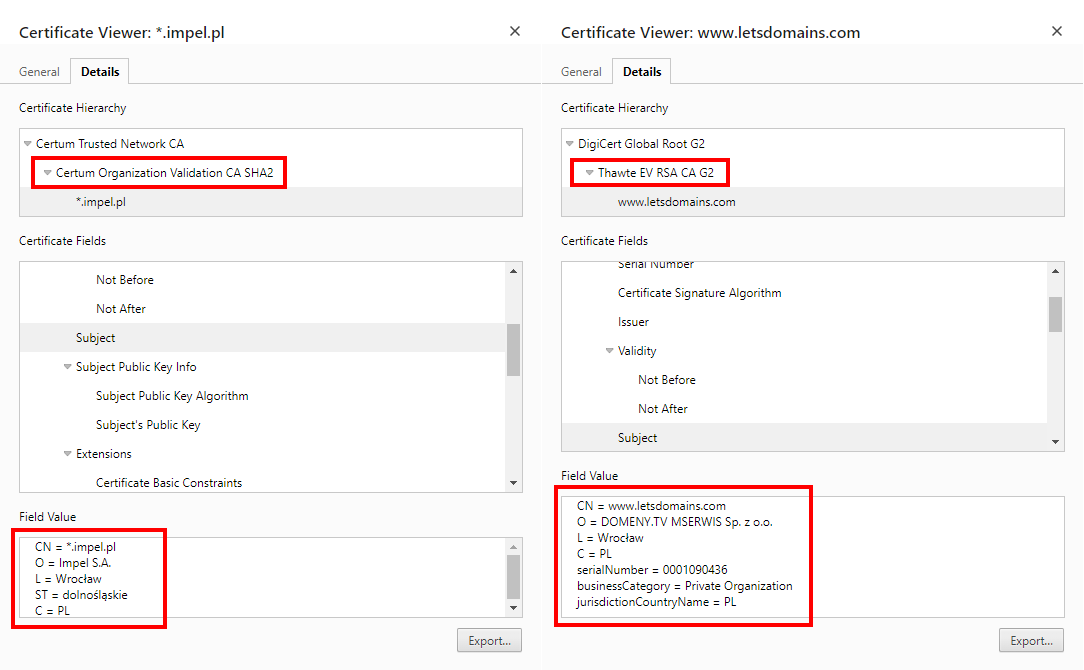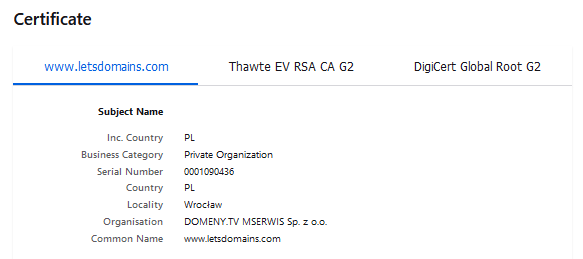Diferențele dintre certificatele OV și EV – de ce să alegi EV?

Certificatul SSL este împărțit în trei tipuri de validare: DV (Validare a Domeniului), OV (Validare a Organizației) și EV (Validare Extinsă). Fiecare oferă niveluri diferite de verificare și încredere, ceea ce este important atât pentru proprietarii de site-uri web, cât și pentru utilizatorii lor.
Pe internet, poți găsi multe informații generale și incomplete despre nivelurile de securitate oferite de diferitele validări și procedurile necesare pentru a le obține. Cu toate acestea, este rar să întâlnești informații precise despre beneficiile și impactul pe care aceste certificate le au asupra ta ca proprietar de site web și asupra utilizatorilor tăi.
În acest articol, vei găsi o discuție detaliată despre atributele certificatelor SSL OV și EV. Vei înțelege cum diferitele niveluri de validare afectează securitatea și încrederea utilizatorilor tăi pe site-ul tău. De asemenea, vei învăța principalele diferențe dintre OV și EV. Descoperă cum să îmbunătățești protecția împotriva atacurilor de phishing. Și, cel mai important, vei înțelege ce distinge cu adevărat certificatele EV și de ce merită investiția.
Tipuri de validare SSL: DV, OV și EV – diferențe
Validarea certificatului SSL este procesul de confirmare că proprietarul domeniului sau organizației este autentic și are dreptul la certificat. Certificatul SSL este împărțit în trei tipuri de validare: DV (Validare a Domeniului), OV (Validare a Organizației) și EV (Validare Extinsă). Fiecare oferă niveluri diferite de verificare și încredere, ceea ce este important atât pentru proprietarii de site-uri web, cât și pentru utilizatorii lor.
În acest articol, vom analiza mai îndeaproape certificatele SSL OV și EV și diferențele dintre ele.
Certificatul DV (Validare a Domeniului)
Primul și cel mai simplu tip de validare este certificatul DV. Procesul de verificare implică doar verificarea dacă controlezi domeniul. Procedura este rapidă și nu necesită documentație. Certificatul DV criptează conexiunea, dar nu oferă informații despre organizația ta.
Certificatul OV (Validare a Organizației)
Certificatul OV verifică atât controlul domeniului, cât și existența organizației tale. Pentru a obține un certificat OV, trebuie să furnizezi documente care dovedesc existența organizației, ceea ce durează mai mult decât validarea DV. Cu certificatele OV, utilizatorii tăi vor vedea informații despre organizație în proprietățile certificatului, ceea ce le crește încrederea în site-ul tău.
Certificatele OV oferă o protecție suplimentară împotriva atacurilor de phishing, permițând clienților să verifice detaliile organizației în proprietățile certificatului. Cu toate acestea, ele nu oferă același nivel de verificare detaliată sau nu afișează numele companiei după ce se face clic pe pictograma de blocare sau pe pictograma de lacăt în browsere, așa cum fac certificatele EV. Certificatele OV sunt potrivite pentru majoritatea site-urilor de afaceri.
Certificatul EV (Validare Extinsă) – diferențe față de OV
Certificatele EV oferă cel mai înalt nivel de încredere și securitate. Pentru a obține un certificat EV, trebuie să treci prin cel mai riguros proces de verificare, care include verificări amănunțite ale existenței legale, fizice și operaționale a organizației tale. Certificatele EV oferă cele mai multe informații despre organizație, inclusiv câmpuri suplimentare în detaliile certificatului, despre care vom discuta în detaliu mai târziu. Aceasta este cea mai bună soluție pentru companii mari, comerț electronic, bănci și alte site-uri care necesită cel mai înalt nivel de încredere.
Certificatele EV oferă un strat suplimentar de protecție prin cea mai riguroasă verificare, oferind informații mai detaliate încorporate în certificat despre companie decât certificatele OV. Acest lucru face mult mai greu pentru escroci să se prezinte ca site-uri legitime, deoarece sunt necesare informații mai detaliate și mai greu de falsificat. Ca rezultat, utilizatorii pot verifica mai ușor credibilitatea site-ului, crescându-le încrederea și sentimentul de securitate atunci când folosesc site-ul.
Certificatele EV afișează numele organizației după ce se face clic pe pictograma de lacăt sau pe pictograma de ton în bara de adrese a browserului, ceea ce este ușor de recunoscut de utilizatori. În trecut, aceasta includea și o bară de adrese verde. Acest indicator crește încrederea utilizatorilor în site, ceea ce nu este oferit de certificatele OV.
Atributele de încredere și vizibilitate ale datelor organizaționale verificate în EV certificate în Chrome (stânga) și Mozilla Firefox (dreapta).
Atributele de încredere și vizibilitate ale datelor organizaționale verificate în OV certificate în Chrome (stânga) și Mozilla Firefox (dreapta).
Certificatele EV oferă adesea sume de garanție mai mari în cazuri de încălcare a securității, cum ar fi accesul neautorizat la date sau atacuri de tip man-in-the-middle, comparativ cu certificatele OV. De exemplu, cu certificatele SECTIGO, varianta OV oferă o garanție de 50.000 USD, în timp ce varianta EV oferă până la 1.750.000 USD.
Cum să verifici nivelul de validare al unui certificat SSL dat?
Poti verifica nivelurile de validare ale certificatelor SSL (DV, OV, EV) în câțiva pași simpli, indiferent de browserul pe care îl folosești. Mai jos sunt pașii pentru a verifica acest lucru în două dintre cele mai populare browsere: Chrome și Mozilla Firefox.
Verificarea tipului de certificat SSL și a nivelului de validare în Chrome
- Deschide site-ul al cărui certificat vrei să-l verifici și fă clic pe pictograma de lacăt din partea stângă a barei URL.
- Selectează opțiunea "Conexiunea este sigură" și apoi fă clic pe "Certificat (Valabil)".
- Se va deschide o fereastră nouă cu informațiile certificatului. Poți verifica tipul certificatului în tab-ul "General" sub câmpul "Emis de".
- În plus, în tab-ul "Detalii", vei găsi toate atributele (proprietățile) certificatului SSL, inclusiv câmpul "Emitent", unde poți găsi și informații despre tipul certificatului.
- Poti determina tipul certificatului revizuind detaliile din tab-ul "Detalii" sub câmpul "Subiect":
- Certificat OV – Vei găsi informații de bază precum "Organizație", "Țară", "Stat", "Oraș".
- Certificat EV – Vor fi afișate câmpuri suplimentare precum "Număr de serie", "Categorie de afaceri", "Țara înregistrată", "Stat" și "Regiune".
Exemplu de certificat cu validare OV și EV în Chrome
Verificarea tipului de certificat SSL și a nivelului de validare în Mozilla Firefox
- Deschide site-ul al cărui certificat vrei să-l verifici și fă clic pe pictograma de lacăt din partea stângă a barei URL.
- Alege "Conexiune sigură" din meniul derulant, apoi "Mai multe informații".
- În fereastra nouă, mergi la tab-ul "Securitate" și fă clic pe "Vizualizare certificat".
- Se va deschide o fereastră nouă cu informațiile certificatului. Poți verifica tipul certificatului în coloana "Numele emitentului".
- Pentru a determina tipul certificatului, verifică coloana "Numele subiectului":
-
- Certificat OV – Aici, vei vedea informații de bază precum "Țară", "Stat", "Regiune", "Organizație" și "Nume Comun".
- Certificat EV – În acest caz, vei vedea câmpuri suplimentare precum "Țara înregistrată", "Categorie de afaceri" și "Număr de serie".
Exemplu de certificat cu validare EV în browserul Mozilla Firefox.
Exemplu de certificat cu validare OV în browserul Mozilla Firefox.
Diferențe în informațiile organizației în certificatele OV și EV în Chrome
Certificatele OV și EV diferă în nivelul de detaliu despre organizația pe care o securizează. Într-un certificat EV, vei găsi câmpuri suplimentare care nu sunt prezente în certificatele OV, deoarece certificatele EV necesită un proces de verificare mai riguros.
Explicația câmpului “Subiect” în detaliile certificatului
În câmpul “Subiect” pentru certificatele OV și EV, vei găsi informații detaliate despre organizație, cum ar fi:
- CN (Nume Comun) – numele principal, de obicei numele de domeniu complet calificat (FQDN) pentru care a fost emis certificatul. Acest câmp identifică domeniul securizat de certificatul SSL.
- O (Organizație) – numele organizației căreia i-a fost emis certificatul. Acest câmp indică numele legal înregistrat al organizației deținătorului certificatului.
- OU (Unitate Organizațională) – divizia sau departamentul din cadrul organizației responsabil pentru certificat. Acest câmp poate specifica un departament anume, cum ar fi departamentul IT.
- L (Localitate) – orașul în care se află organizația.
- ST (Stat sau Provincie) – statul sau provincia în care este înregistrată organizația.
- C (Țară) – țara în care este înregistrată organizația.
Explicația câmpurilor suplimentare în atributele certificatului EV
Pentru certificatele EV, vei găsi câmpuri suplimentare:
- serialNumber – numărul de înregistrare al organizației. Aceste informații suplimentare ajută la identificarea unică a organizației, în special pentru companiile mari care gestionează mai multe certificate.
- businessCategory – categoria de afaceri, care poate fi specificată ca “Organizație Privată,” “Entitate Guvernamentală,” “Entitate de Afaceri,” sau “Entitate Non-comercială.”
- jurisdictionCountryName – indică țara în care organizația este înregistrată legal.
- jurisdictionStateOrProvinceName – (dacă este cazul) statul sau provincia în care organizația este înregistrată legal.
De ce informațiile detaliate despre organizație sunt prezente în EV, dar nu în OV?
Certificatele EV sunt concepute pentru a oferi cel mai înalt nivel de încredere și securitate, ceea ce este deosebit de important pentru site-uri precum bănci, platforme de comerț electronic care procesează cantități mari de date ale clienților, servicii HR care gestionează informații despre angajați, servicii medicale și alte organizații care necesită un nivel ridicat de securitate. Certificatele EV trec printr-o verificare mai detaliată decât certificatele OV și conțin mai multe informații pentru a asigura că utilizatorii pot avea încredere deplină în identitatea site-ului. Acest lucru include verificarea înregistrării legale a companiei, a locației fizice și a autorizației de a opera în jurisdicția dată.
Concluzie – de ce să alegi un certificat EV?
Certificatele SSL sunt împărțite în trei tipuri de validare: DV, OV și EV. Certificatele DV sunt cele mai simple, verificând doar controlul domeniului, dar neavând informații despre organizație.
Certificatele OV verifică atât controlul domeniului, cât și existența organizației. Ele necesită documente care dovedesc existența companiei și verificarea de către un angajat al emitentului certificatului. Cu certificatele OV, utilizatorii pot vedea detalii despre organizație, cum ar fi numele, țara, statul și orașul în proprietățile certificatului, crescând încrederea în site.
Certificatele EV oferă cel mai înalt nivel de încredere și securitate prin cel mai riguros proces de verificare, care include verificări amănunțite ale existenței legale și operaționale a organizației. Ele oferă cele mai multe informații despre organizație, inclusiv date suplimentare precum numărul de înregistrare al companiei, tipul de afacere și țara de încorporare. Acest lucru face ca certificatele EV să fie mai greu de contrafăcut, ajutând utilizatorii să recunoască site-urile legitime și oferind o protecție suplimentară împotriva atacurilor de phishing.
Certificatele EV afișează numele organizației în bara de adrese a browserului, crescând semnificativ încrederea utilizatorului. Ele oferă adesea sume de garanție mai mari decât OV în cazuri de încălcare a securității, oferind un suport financiar mai mare din partea emitentului certificatului.
Reține: Ca utilizator, ești vulnerabil la atacuri atunci când crezi greșit că criptarea singură garantează o securitate completă. Pentru siguranța ta, ar trebui să știi că poți verifica detaliile certificatului SSL și să verifici autenticitatea site-urilor. Acest lucru te poate proteja de consecințe neplăcute.
Asigură cel mai înalt nivel de securitate și încredere pentru utilizatorii tăi și comandă un certificat EV sau OV astăzi.
Întrebări frecvente – certificate OV vs. EV
1. Care este principala diferență între certificatele SSL OV și EV?
OV verifică detaliile organizației, dar arată date limitate în certificat. EV include verificare extinsă și afișează mai multe informații legale și de afaceri, sporind încrederea utilizatorului.
2. Certificatele EV mai arată bara de adrese verde?
Nu mai. Browserele moderne arată numele companiei în detaliile certificatului atunci când se face clic pe pictograma de lacăt, dar bara verde a fost eliminată pentru simplificarea interfeței utilizatorului.
3. Sunt certificatele EV mai greu de obținut?
Da. Ele necesită documentație strictă, inclusiv dovada existenței legale, a adresei fizice și a statutului operațional.
4. Care site-uri ar trebui să folosească certificate EV?
Băncile, site-urile de comerț electronic, serviciile de sănătate, portalurile HR și orice afacere care gestionează date sensibile ale utilizatorilor ar trebui să ia în considerare cu tărie certificatele EV.
5. Merită certificatele EV costul suplimentar?
Da. Ele oferă o încredere mai mare, o protecție mai puternică împotriva phishing-ului și o acoperire mai mare a garanției comparativ cu OV.
Promovez serviciile, produsele și software-ul nostru. Lucrez îndeaproape cu echipele de dezvoltare și suport, creez campanii și conținut, gestionez rețelele sociale și traduc concepte tehnice complexe în comunicare clară pentru clienții noștri.






















